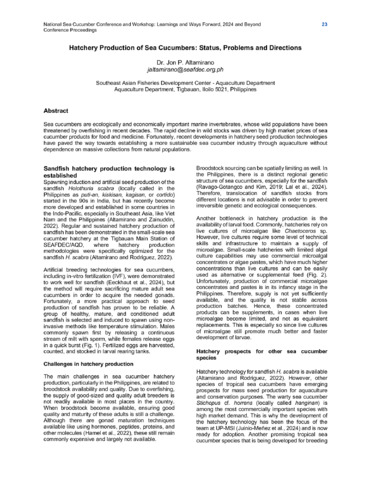| dc.contributor.author | Lal, Monal | |
| dc.contributor.author | Macahig, Deo A. S. | |
| dc.contributor.author | Juinio-Meñez, Marie Antonette | |
| dc.contributor.author | Altamirano, Jon | |
| dc.contributor.author | Noran-Baylon, Roselyn D. | |
| dc.contributor.author | de la Torre-de la Cruz, Margarita | |
| dc.contributor.author | Villamor, Janine L. | |
| dc.contributor.author | Gacura, Jonh Rey | |
| dc.contributor.author | Uy, Wilfredo | |
| dc.contributor.author | Mira-Honghong, Hanzel | |
| dc.contributor.author | Southgate, Paul C. | |
| dc.contributor.author | Ravago-Gotanco, Rachel June | |
| dc.coverage.spatial | Celebes Sea | en |
| dc.coverage.spatial | Philippine Sea | en |
| dc.coverage.spatial | South China Sea | en |
| dc.coverage.spatial | Sulu Sea | en |
| dc.coverage.spatial | Philippines | en |
| dc.date.accessioned | 2024-06-06T06:15:52Z | |
| dc.date.available | 2024-06-06T06:15:52Z | |
| dc.date.issued | 2024-06-04 | |
| dc.identifier.citation | Lal, M. M., Macahig, D. A. S., Juinio-Meñez, M. A., Altamirano, J. P., Noran-Baylon, R., De La Torre-de La Cruz, M., Villamor, J. L., Gacura, J. R. L., Uy, W. H., Mira-Honghong, H., Southgate, P. C., & Ravago-Gotanco, R. (2024). Complex patterns of genetic structure in the sea cucumber Holothuria (Metriatyla) scabra from the Philippines: Implications for aquaculture and fishery management. Frontiers in Marine Science, 11, 1396016. https://doi.org/10.3389/fmars.2024.1396016 | en |
| dc.identifier.issn | 2296-7745 | |
| dc.identifier.uri | http://hdl.handle.net/10862/6536 | |
| dc.description | The Supplementary Material for this article can be found online at: https://www.frontiersin.org/articles/10.3389/fmars.2024.1396016/full#supplementary-material | en |
| dc.description.abstract | The sandfish Holothuria (Metriatyla) scabra, is a high-value tropical sea cucumber harvested from wild stocks for over four centuries in multi-species fisheries across its Indo-Pacific distribution, for the global bêche-de-mer (BDM) trade. Within Southeast Asia, the Philippines is an important centre of the BDM trade, however overharvesting and largely open fishery management have resulted in declining catch volumes. Sandfish mariculture has been developed to supplement BDM supply and assist restocking efforts; however, it is heavily reliant on wild populations for broodstock supply. Consequently, to inform fishery, mariculture, germplasm and translocation management policies for both wild and captive resources, a high-resolution genomic audit of 16 wild sandfish populations was conducted, employing a proven genotyping-by-sequencing approach for this species (DArTseq). Genomic data (8,266 selectively-neutral and 117 putatively-adaptive SNPs) were used to assess fine-scale genetic structure, diversity, relatedness, population connectivity and local adaptation at both broad (biogeographic region) and local (within-biogeographic region) scales. An independent hydrodynamic particle dispersal model was also used to assess population connectivity. The overall pattern of population differentiation at the country level for H. scabra in the Philippines is complex, with nine genetic stocks and respective management units delineated across 5 biogeographic regions: (1) Celebes Sea, (2) North and (3) South Philippine Seas, (4) South China and Internal Seas and (5) Sulu Sea. Genetic connectivity is highest within proximate marine biogeographic regions (mean Fst=0.016), with greater separation evident between geographically distant sites (Fst range=0.041–0.045). Signatures of local adaptation were detected among six biogeographic regions, with genetic bottlenecks at 5 sites, particularly within historically heavily-exploited locations in the western and central Philippines. Genetic structure is influenced by geographic distance, larval dispersal capacity, species-specific larval development and settlement attributes, variable ocean current-mediated gene flow, source and sink location geography and habitat heterogeneity across the archipelago. Data reported here will inform accurate and sustainable fishery regulation, conservation of genetic diversity, direct broodstock sourcing for mariculture and guide restocking interventions across the Philippines. | en |
| dc.description.sponsorship | The author(s) declare financial support was received for the research, authorship, and/or publication of this article. Australian Centre for International Agriculture Research (ACIAR) project FIS/2016/122: “Increasing technical skills supporting community-based sea cucumber production in Vietnam and the Philippines”. Philippine Council for Agriculture, Aquatic and Natural Resources Research and Development of the Department of Science and Technology (DOST-PCAARRD: Project Numbers QSR-MR-CUC.02.01 and QSR-MR-CUC.02.02). | en |
| dc.language.iso | en | en |
| dc.publisher | Frontiers Media | en |
| dc.relation.uri | https://www.frontiersin.org/articles/10.3389/fmars.2024.1396016/pdf | en |
| dc.rights | Attribution 4.0 International | * |
| dc.rights.uri | https://creativecommons.org/licenses/by/4.0/ | * |
| dc.subject | Holothuria scabra | en |
| dc.subject | germplasm | en |
| dc.title | Complex patterns of genetic structure in the sea cucumber Holothuria (Metriatyla) scabra from the Philippines: implications for aquaculture and fishery management | en |
| dc.type | Article | en |
| dc.identifier.doi | 10.3389/fmars.2024.1396016 | |
| dc.citation.volume | 11 | en |
| dc.citation.spage | 1396016 | en |
| dc.citation.journalTitle | Frontiers in Marine Science | en |
| dc.subject.asfa | sea cucumber fisheries | en |
| dc.subject.asfa | aquaculture | en |
| dc.subject.asfa | fishery management | en |
| dc.subject.asfa | genetic structures | en |
| dc.subject.asfa | genotypes | en |
| dc.subject.asfa | gene flow | en |
| dc.subject.asfa | genomics | en |
| dc.subject.asfa | hydrodynamics | en |
| dc.subject.scientificName | Holothuria scabra | en |
| dc.subject.scientificName | Metriatyla | en |
| local.subject | sea cucumber | en |
| local.subject | SNP | en |
| local.subject | genetic structure | en |
| local.subject | fishery management | en |
| local.subject | dispersal | en |
| local.subject | Philippines | en |
| local.subject | conservation | en |
| local.subject | mariculture | en |
| dc.subject.sdg | SDG 14 - Life below water | en |









